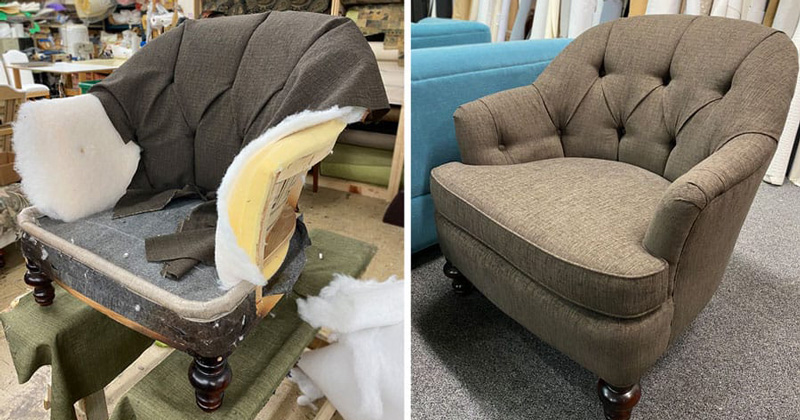Restore, Don't Replace: Upholstery Repair Solutions You Can Trust
Restore, Don't Replace: Upholstery Repair Solutions You Can Trust
Blog Article
The Ultimate Guide to Upholstery Repair Strategies
In the realm of furnishings upkeep, the art of furniture fixing is an ability that can rejuvenate worn-out pieces and protect valued possessions. As we browse the globe of upholstery fixing strategies, we run into a myriad of techniques that can change a worn out couch or chair into a rejuvenated centerpiece of an area. From analyzing the damage to carefully repairing tears and holes, each step in the process holds the crucial to reviving furnishings to its former glory. Stay tuned as we unravel the ins and outs of this craft and reveal the keys to mastering furniture repair service methods that will boost your furnishings repair undertakings.
Assessing Upholstery Damage
When assessing furniture damages, it is vital to carry out a complete evaluation to precisely establish the level of the concerns existing. This preliminary action is essential in creating an extensive fixing plan that attends to all aspects of the damages properly. Begin by aesthetically checking the upholstery for any visible rips, slits, spots, or discoloration. Bear in mind of the location and size of each imperfection as this info will guide the repair service process.
Next, evaluate the hidden framework of the furniture to look for any damage to the structure, springs, or padding. Occasionally, the damages might not be right away visible on the surface area but might substantially affect the overall integrity of the upholstery. By thoroughly analyzing both the outside upholstery and inner components, you can guarantee that all concerns are determined and suitably attended to throughout the repair service procedure.
Additionally, consider the sort of furniture product made use of as different textiles and leathers may require certain repair service strategies. upholstery repair. Comprehending the material residential properties will help in selecting one of the most ideal repair work techniques and items to achieve ideal results
Essential Tools and Materials
To effectively perform upholstery repairs, having the proper tools and products is vital for accomplishing expert outcomes. Crucial devices for upholstery repair service include a staple gun for securing material, upholstery needles and thread for sewing, scissors for reducing material, a rubber club for touching in furniture parts, and pliers for removing old staples and nails. In addition, having a fabric marker for laying out patterns, a joint ripper for downfall joints, and a warm adhesive weapon for fast repairs can be beneficial. Materials such as furniture textile, foam batting, webbing, and cushioning are crucial for replacing damaged components. It is also crucial to have a selection of furniture adds, nails, and staples on hand for securing fabric and trim. Adhesives like material glue or spray adhesive work for sure repair services. By guaranteeing you have the essential devices and products prior to beginning an upholstery repair work job, you can work effectively and successfully to restore furniture to its former magnificence.
Preparing the Furniture Surface Area
Prep work of the furniture surface is an important initial step in making certain the effective outcome of any furniture repair service project. Prior to beginning any repair, it is vital to thoroughly cleanse the furniture surface area to get rid of dirt, dust, and any kind of various other debris that can disrupt the attachment of new products. This can be done utilizing a vacuum cleaner, a soft brush, or a wet cloth, relying on the kind of furniture and the level of dirt present.
When the surface area is clean, any loosened or damaged upholstery textile, cushioning, or springtimes must be carefully eliminated. This action is vital to make sure that the brand-new materials stick firmly and that the repaired furniture maintains a professional and smooth appearance. In addition, any type of old staples or tacks should be drawn out, and the surface must be evaluated for any structural damage that may require to be addressed before continuing with the fixing.

Fixing Holes and splits
After making sure the furnishings surface area is complimentary of dirt, particles, and dust and getting rid of any kind of loosened or broken upholstery materials, the next step in furniture fixing entails addressing rips and straight from the source openings in the textile. Fixing splits and holes in furniture can aid expand the life of your furnishings and restore its aesthetic allure. One usual technique for dealing with small rips and holes is by utilizing a needle and string to stitch the sides of the broken area back with each other. For bigger tears or openings, a spot of textile can be made use of to cover and strengthen the damaged area (upholstery repair). Material glue or adhesive can also be utilized to safeguard the patch in place. It is very important to meticulously match the shade and appearance of the spot fabric to the initial furniture for a seamless fixing. As soon as the tear or hole is fixed, make certain that the location is appropriately cleansed and dried out before making use of the furniture once more to avoid any further damages.
Getting Rid Of Odors and discolorations
Dealing with persistent discolorations and sticking around odors in upholstery requires a targeted and complete approach to guarantee efficient reconstruction of the textile's appearance and quality. Discolorations can be triggered by various compounds such as food spills, family pet crashes, or drink accidents, while odors commonly originate from smoke, pet dog dander, or spills passing through the furniture fibers. To tackle spots, it is vital to recognize the sort of tarnish initial to use the proper cleaning remedy. For water-based spots, blotting with a mix of mild cleaning agent and water can be efficient, while oil-based discolorations may call for a solvent-based cleanser. Odors, on the other hand, demand a deeper cleansing procedure that involves reducing the effects of the resource of the odor rather than masking it. Using baking soda or specialized upholstery deodorizers can help eliminate odors efficiently. In some situations, professional cleaning company might be required for severe stains and smells that continue in spite of natural home remedy. Regular upkeep and punctual interest to spills can aid in preventing deep-seated discolorations and smells, protecting the upholstery's problem.

Verdict
Finally, grasping furniture repair methods needs mindful evaluation of damages, making use of essential tools and products, correct preparation of the furnishings surface area, and the skillful repair work of splits, odors, spots, and holes. By complying with these steps, individuals can successfully recover and lengthen the life of their furnishings.

Crucial devices for upholstery repair work include a staple weapon for safeguarding material, furniture needles and thread for sewing, scissors for reducing material, a rubber mallet for touching in furniture parts, and pliers for getting rid of old staples and nails. By ensuring you have the necessary devices and products before beginning an upholstery repair task, you can work efficiently and properly to bring back furniture to its previous splendor.
Prep work of the furniture surface area is a vital preliminary action in making sure the successful outcome of any kind of furniture repair task.After guaranteeing the furnishings surface is cost-free of dirt, debris, and dirt and getting rid of any click to read more type of broken my response or loose furniture materials, the following action in upholstery repair includes resolving splits and holes in the textile - upholstery repair. Fixing rips and holes in furniture can help expand the life of your furniture and restore its visual appeal
Report this page